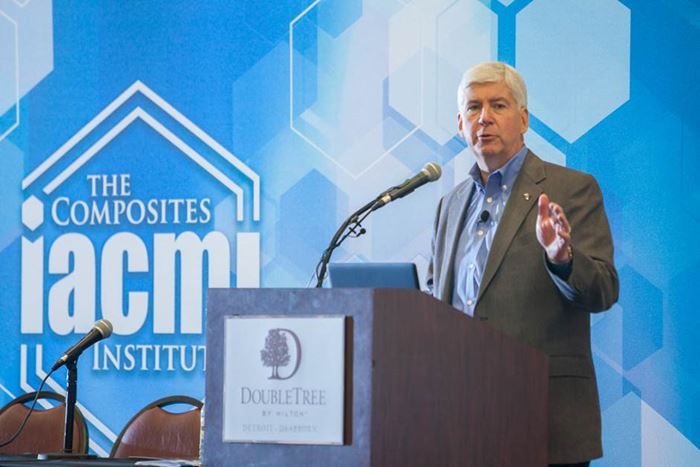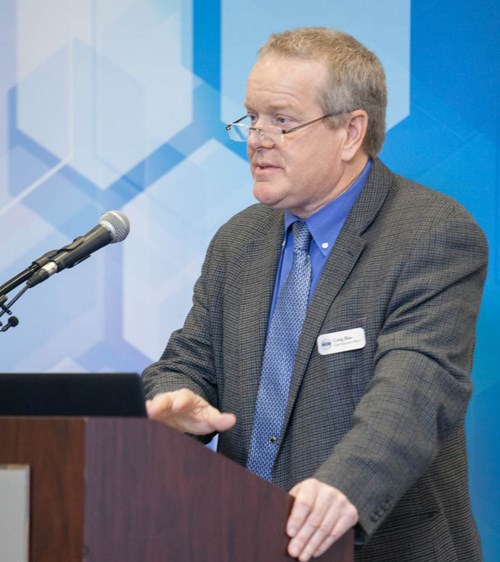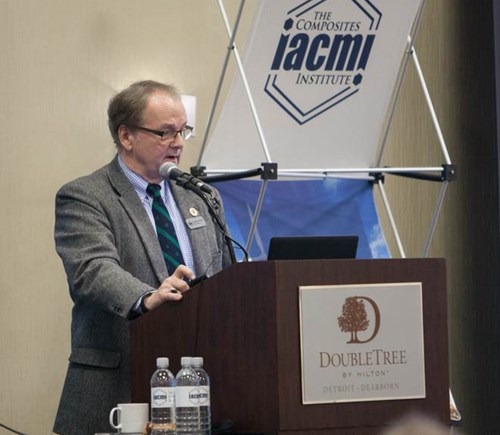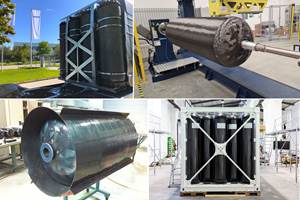IACMI starting to walk the talk
The Institute for Advanced Composites Manufacturing Innovation (IACMI) is six months into its five-year life and is showing signs of collaborative-based innovation.
The Institute for Advanced Composites Manufacturing Innovation (IACMI, Knoxville, TN, US), the $259 million public/private consortium designed to accelerate composite materials and process development, held its second membership meeting in Detroit, MI, US, Jan. 13-14 to coincide with the North American International Auto Show (NAIAS).
The meeting was the first after IACMI’s formation in June 2015 and was designed to bring members — suppliers, OEMs, academia, government officials — up to speed on the consortium’s activities. IACMI is organized around five focus areas (automotive, pressure vessels, wind, process engineering and design engineering), with specific goals associated with each. IACMI members are encouraged to develop collaborative partnerships to pursue projects affiliated with a goal or goals, and then solicit funding from IACMI. Projects can be developed ad hoc, or organized to meet a request for proposal (RFP), the first of which IACMI issued in fall 2015.
The US composites industry has never had such a well-funded public/private consortium, so many of the 290 members at the meeting were eager to hear of tangible progress being made, and were not disappointed.
Most notable was the announcement by Larry Drzal, director vehicle technology area (VTA) at IACMI, and Ray Boeman, associate director VTA, about the establishment of an IACMI technical center in the Corktown neighborhood of Detroit that will be used for research and development and pre-production operations for prepregging, resin transfer molding (RTM), compression molding, injection overmolding, finishing and material formulation. The building is currently partially occupied by Lightweight Innovations for Tomorrow (LIFT), a consortium that focuses on development of metals manufacturing. IACMI will have 31,000 ft2 of high-bay space and another 8,000 ft2 of space shared with LIFT. The press at the facility is coming from Schuler and the prepregger is coming from TenCate. The RTM equipment and the injection molding machine will be ordered soon. The IACMI scale-up facility is expected to be up and running later this year.
For proof of innovation progress, IACMI offered Felix Nguyen, principal research Scientist at Toray, who talked about a collaborative effort with Globe Machine, Janicki Industries and Roctool to develop automated fast-cure prepreg materials for compression molding of automotive composite parts. Peter Fritz, engineering specialist at Eaton, discussed his company’s IACMI proposal to develop a composite differential case for automotive driveline use that could show mass savings of 40-50%. The design uses a metal skeleton overmolded with a composite material. Fritz said the project is focusing on cost-reduction strategies to get the part into production and that it is near technological readiness level (TRL) 6.
Doug Adams, technical fellow in non-destructive evaluation (NDE) at Vanderbilt University, talked broadly about IACMI’s goals to improve composites fabrication process control and discussed the role that robust NDE might play. Specifically, he addressed the need for faster, large-area NDE technology that allows fabricators to assess process and product quality in real time, when it is easiest and cheapest to correct errors. He also discussed the value of cure monitoring technologies to help optimize fabrication processes and avoid part over-cure.
Dale Brosius, IACMI chief commercialization officer and CW columnist, walked the membership through the consortium’s goals for the five years covering the initial funding window of the program. At the top of this list is the goal to make IACMI sustainable beyond the initial five years. Doing so, however, will require that many of the initial goals be met, including: 25% reduction in carbon fiber composite cost, 50% reduction in carbon fiber composites embodied energy and 80% composites recyclability into useful products. In addition, IACMI is tasked with reducing lifecycle energy consumption, increasing domestic production capacity, job growth and establishing an advanced training program. The first commercialization of an IACMI technology must be achieved by month 24 of the program; 20 such commercializations must occur by the end of the five years. 500 people must complete the IACMI training program within five years.
Along those lines, IACMI is establishing an internship program with IACMI partners, as well as the FIRST Robotics Competition. Further, the consortium is hosting a series of workshops in 2016, each located in one of IACMI’s technology regions:
- Process & Advanced Materials Workshop – April 5-6, Knoxville, TN (Oak Ridge National Lab)
- Intermediate Processing & Wind Energy Workshop – June 14-15, Denver, CO (NREL)
- Process & Advanced Materials Workshop – August 9-10, West Lafayette, IN (Purdue University)
- Process & Automotive Market Advances in Composites – November 1-2, Detroit, MI (Michigan State University)
Derek Berry, director of the IACMI wind technology area and affiliated with the National Renewable Energy Laboratory (NREL) in Colorado, discussed IACMI’s goals to reduce wind blade weight, increase wind blade fabrication automation and reduce wind blade cost. The first project is a cooperative effort involving wind blade maker TPI Composites, Johns-Manville, Arkema and NREL to assess possible application of Arkema’s closed-molding compatible Elium thermoplastic, as well as a nylon 6, in wind blade spar caps. Other projects on the IACMI wind horizon are spar cap pultrusion, recycling, additive manufacturing and automation.
In pressure vessels, Jared Stonecash, from the University of Dayton Research Institute (UDRI), discussed IACMI’s goal of reducing the cost of Class IV (polymer-lined) tank fabrication by 30% by 2018, and 50% by 2024. The first project along these lines will pick up work on a braided overwrap tank design first developed about five years ago by A&P Technology and Profile Composites. A&P is working on the IACMI project as well and will cooperate with UDRI and xperion Energy & Environment.
Finally, Byron Pipes, professor at IACMI member Purdue University, updated the membership on IACMI’s efforts to increase the sophistication, capability and reliability of the composites industry’s digital design and simulation tools. Pipes has put together the Composites Design & Manufacturing HUB (cdmHUB), a web-based design and collaboration platform that will, when fully functional, integrate each type of digital tool required for composites design, ranging from 2D design, to 3D design, to finite element analysis, to ply orientation and simulation. Pipes says cdmHUB should be fully functional by 2017.
IACMI is still accepting membership applications. Interested companies and organizations are encouraged to contact the consortium to explore options and costs. The next IACMI membership meeting will be in July at Purdue University in West Lafayette, IN.
Related Content
Composites end markets: Pressure vessels (2024)
The market for pressure vessels used to store zero-emission fuels is rapidly growing, with ongoing developments and commercialization of Type 3, 4 and 5 tanks.
Read MoreLilium launches M&A process, targets eVTOL program continuation
Despite court-approved insolvency filings and beginning first investor briefings, Lilium remains fully focused on re-emerging following restructuring, setting its sights on fresh investment to support the Lilium Jet.
Read MoreParis Air Show 2023 highlights
The Paris Air Show, one of the largest aerospace trade shows in the world, returned for the first time since 2019 and proved that the global aviation industry industry is very much alive and kicking.
Read MorePlant tour: Joby Aviation, Marina, Calif., U.S.
As the advanced air mobility market begins to take shape, market leader Joby Aviation works to industrialize composites manufacturing for its first-generation, composites-intensive, all-electric air taxi.
Read MoreRead Next
VIDEO: High-volume processing for fiberglass components
Cannon Ergos, a company specializing in high-ton presses and equipment for composites fabrication and plastics processing, displayed automotive and industrial components at CAMX 2024.
Read More“Structured air” TPS safeguards composite structures
Powered by an 85% air/15% pure polyimide aerogel, Blueshift’s novel material system protects structures during transient thermal events from -200°C to beyond 2400°C for rockets, battery boxes and more.
Read MoreAll-recycled, needle-punched nonwoven CFRP slashes carbon footprint of Formula 2 seat
Dallara and Tenowo collaborate to produce a race-ready Formula 2 seat using recycled carbon fiber, reducing CO2 emissions by 97.5% compared to virgin materials.
Read More
































